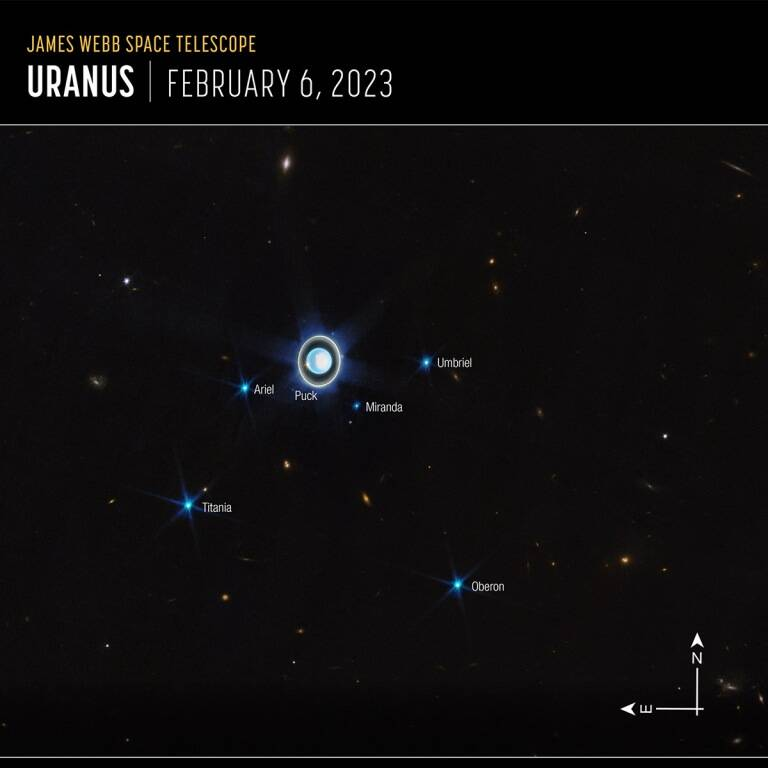Important Facts For Prelims
James Webb Space Telescope Captures Uranus and its Rings
- 11 Apr 2023
- 5 min read
Why in News?
The James Webb Space Telescope, launched in 2021, has captured a clear image of the planet Uranus and its rings.
What are the Major Points Related to Uranus?
- Uranus is an ice giant due to the chemical makeup of its interior, with most of its mass being a hot and dense fluid of icy materials like water, methane, and ammonia.
- Uranus rotates on its side, with a roughly 90-degree angle from the plane of its orbit. This leads to extreme seasons and long periods of sunlight and darkness.
- Uranus is among only two planets in our solar system that rotate clockwise along with Venus.
- The planet takes 84 earth years to orbit the Sun.
- Uranus has 13 rings, with 11 visible in the image. Some of the rings are very bright and close together, appearing as a larger ring.
- The planet also has 27 known moons.
- Uranus has a unique polar cap that appears during summer and vanishes in the fall. Webb's data can help scientists understand this mechanism.
- In 1986, NASA's Voyager 2 made the first - and so far, the only - visit to Uranus.
- New Horizons passes the orbit of Uranus on its way to Pluto, becoming the first spacecraft to journey beyond Uranus' orbit since Voyager 2.
What is a James Webb Space Telescope?
- The James Webb Space Telescope (JWST) is a large, infrared telescope designed to observe the most distant objects in the universe.
- The JWST is the successor to the Hubble Space Telescope.
- It is a collaboration between NASA, the European Space Agency (ESA), and the Canadian Space Agency (CSA).
- The telescope was launched in December 2021 and is currently at a point in space known as the Sun-Earth L2 Lagrange point, approximately 1.5 million km beyond Earth’s orbit around the Sun.
- Lagrange Point 2 is one of the five points in the orbital plane of the Earth-Sun system.
- Lagrange Points are positions in space where the gravitational forces of a two-body system (like the Sun and the Earth) produce enhanced regions of attraction and repulsion.
- Its primary mission is to study the early universe, the formation of galaxies, stars, and planets, and the atmospheres of exoplanets.
UPSC Civil Services Examination Previous Year Question (PYQ)
Prelims
Q. Which of the following pairs is/are correctly matched? (2014)
Spacecraft Purpose
- Cassini-Huygens : Orbiting the Venus and transmitting data to the Earth
- Messenger : Mapping and investigating the Mercury
- Voyager 1 and 2 : Exploring the outer solar system
Select the correct answer using the code given below:
(a) 1 only
(b) 2 and 3 only
(c) 1 and 3 only
(d) 1, 2 and 3
Ans: (b)
- Cassini-Huygens was sent to study Saturn and its moons. It was a joint collaboration between NASA and European Space Agency. It was launched in 1997 and entered Saturn’s orbit in 2004. The mission ended in 2017. Hence, pair 1 is not correctly matched.
- Messenger, a spacecraft by NASA was sent to map and investigate Mercury. It was launched in 2004 and entered Mercury’s orbit in 2011. The mission ended in 2015. Hence, pair 2 is correctly matched.
- Voyager 1 and 2 were launched by NASA in 1977 to explore the outer solar system. Both the spacecrafts are still operational. Hence, pair 3 is correctly matched.
- Therefore, option (b) is the correct answer.
Mains
Q. Launched on 25th December, 2021, James Webb Space Telescope has been much in the news since then. What are its unique features which make it superior to its predecessor Space Telescopes? What are the key goals of this mission? What potential benefits does it hold for the human race? (2022)







